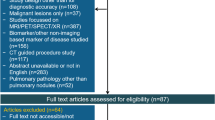Abstract
Objective
To assess diagnostic performance of dual-input CT perfusion for distinguishing malignant from benign solitary pulmonary nodules (SPNs).
Methods
Fifty-six consecutive subjects with SPNs underwent contrast-enhanced 320-row multidetector dynamic volume CT. The dual-input maximum slope CT perfusion analysis was employed to calculate the pulmonary flow (PF), bronchial flow (BF), and perfusion index \( \left( {\mathrm{PI},={{\mathrm{PF}} \left/ {{\left( {\mathrm{PF} + \mathrm{BF}} \right)}} \right.}} \right) \). Differences in perfusion parameters between malignant and benign tumours were assessed with histopathological diagnosis as the gold standard. Diagnostic value of the perfusion parameters was calculated using the receiver-operating characteristic (ROC) curve analysis.
Results
Amongst 56 SPNs, statistically significant differences in all three perfusion parameters were revealed between malignant and benign tumours. The PI demonstrated the biggest difference between malignancy and benignancy: 0.30 ± 0.07 vs. 0.51 ± 0.13 , P < 0.001. The area under the PI ROC curve was 0.92, the largest of the three perfusion parameters, producing a sensitivity of 0.95, specificity of 0.83, positive likelihood ratio (+LR) of 5.59, and negative likelihood ratio (−LR) of 0.06 in identifying malignancy.
Conclusions
The PI derived from the dual-input maximum slope CT perfusion analysis is a valuable biomarker for identifying malignancy in SPNs. PI may be potentially useful for lung cancer treatment planning and forecasting the therapeutic effect of radiotherapy treatment.
Key Points
• Modern CT equipment offers assessment of vascular parameters of solitary pulmonary nodules (SPNs)
• Dual vascular supply was investigated to differentiate malignant from benign SPNs.
• Different dual vascular supply patterns were found in malignant and benign SPNs.
• The perfusion index is a useful biomarker for differentiate malignancy from benignancy.





Similar content being viewed by others
Abbreviations
- DI-CTP:
-
Dual-input maximum slope CT perfusion
- SPN:
-
Solitary pulmonary nodule
- PA:
-
Pulmonary artery
- BA:
-
Bronchial artery
- TDCs:
-
Time density curves
- PF:
-
Pulmonary flow
- BF:
-
Bronchial flow
- \( \left( {\mathrm{PI},={{\mathrm{PF}} \left/ {{\left( {\mathrm{PF} + \mathrm{BF}} \right)}} \right.}} \right) \) :
-
Perfusion index
- ROI:
-
Region of interest
- ROC curve:
-
Receiver-operating characteristic curve
- +LR:
-
Positive likelihood ratio
- −LR:
-
Negative likelihood ratio
References
Milne EN (1967) Circulation of primary and metastatic pulmonary neoplasms: a postmortem microarteriographic study. Am J Roentgenol Radium Ther Nucl Med 100:603–619
Yuan X, Zhang J, Ao G et al (2012) Lung cancer perfusion: can we measure pulmonary and bronchial circulation simultaneously? Eur Radiol 22:1665–1671
Nair A, Hansell DM (2011) European and North American lung cancer screening experience and implications for pulmonary nodule management. Eur Radiol 21:2445–2454
Sitartchouk I, Roberts HC, Pereira AM et al (2008) Computed tomography perfusion using first pass methods for lung nodule characterization. Invest Radiol 43:349–358
Li Y, Yang ZG, Chen TW et al (2010) First-pass perfusion imaging of solitary pulmonary nodules with 64-detector row CT: comparison of perfusion parameters of malignant and benign lesions. Br J Radiol 83:785–790
Zhang M, Kono M (1997) Solitary pulmonary nodules: evaluation of blood flow patterns with dynamic CT. Radiology 205:471–478
Lee YH, Kwon W, Kim MS et al (2010) Lung perfusion CT: the differentiation of cavitary mass. Eur J Radiol 73:59–65
Valentin J (2007) Managing patient dose in multi-detector computed tomography (MDCT). Ann ICRP 37:1–79
Luo L, Wang H, Ma H et al (2010) Analysis of 41 cases of primary hypervascular non-small cell lung cancer treated with embolization of emulsion of chemotherapeutics and iodized oil. Zhongguo Fei Ai Za Zhi 13:540–543
Kiessling F, Boese J, Corvinus C (2004) Perfusion CT in patients with advanced bronchial carcinomas: a novel chance for characterization and treatment monitoring? Eur Radiol 14:1226–1233
Ohno Y, Koyama H, Matsumoto K et al (2011) Differentiation of malignant and benign pulmonary nodules with quantitative first-pass 320-detector row perfusion CT versus FDG PET/CT. Radiology 258:599–609
McCullagh A, Rosenthal M, Wanner A et al (2010) The bronchial circulation–worth a closer look: a review of the relationship between the bronchial vasculature and airway inflammation. Pediatr Pulmonol 45:1–13
Wang J, Ning W, Cham MD et al (2009) Tumor response in patients with advanced non–small cell lung cancer: perfusion CT evaluation of chemotherapy and radiation therapy. AJR Am J Roentgenol 193:1090–1096
He H, Lyness JM, McDermott MP (2009) Direct estimation of the area under the receiver operating characteristic curve in the presence of verification bias. Stat Med 28:361–376
Goehring C, Perrier A, Morabia A (2004) Spectrum bias: a quantitative and graphical analysis of the variability of medical diagnostic test performance. Stat Med 23:125–135
Bhandari M, Guyatt GH (2005) How to appraise a diagnostic test. World J Surg 29:561–566
Marten K, Grabbe E (2003) The challenge of the solitary pulmonary nodule: diagnostic assessment with multislice spiral CT. Clin Imaging 27:156–161
Tsai HY, Tung CJ, Yu CC, Tyan YS (2007) Survey of computed tomography scanners in Taiwan: dose descriptors, dose guidance levels, and effective doses. Med Phys 34:1234–1243
Galanski M, Nagel HD, Stamm G (2007) Results of a federation inquiry 2005/2006: pediatric CT X-ray practice in Germany. Rofo 179:1110–1111
Acknowledgements
The authors thank Dr. Kolo of Toshiba Medical Systems for outstanding technical assistance in this study.
Xiadong Yuan and Jing Zhang contributed equally to this work.
Author information
Authors and Affiliations
Corresponding author
Rights and permissions
About this article
Cite this article
Yuan, X., Zhang, J., Quan, C. et al. Differentiation of malignant and benign pulmonary nodules with first-pass dual-input perfusion CT. Eur Radiol 23, 2469–2474 (2013). https://doi.org/10.1007/s00330-013-2842-x
Received:
Revised:
Accepted:
Published:
Issue Date:
DOI: https://doi.org/10.1007/s00330-013-2842-x




